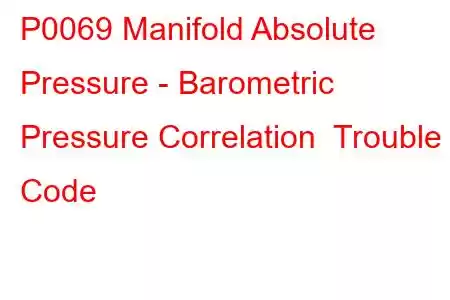P0069 Manifold Absolute Pressure - Barometric Pressure Correlation
OBD-II Trouble Code Technical Description
Manifold Absolute Pressure - Barometric Pressure Correlation
What does that mean?
This generic powertrain/engine diagnostic trouble code typically applies to all OBDII equipped engines, but shows up more often in certain Audi, Ford, Mazda, Mitsubishi, Saturn and VW vehicles.
The Manifold Absolute Pressure (MAP) sensor converts engine vacuum into an electrical signal for the Powertrain Control Module (PCM). The engine may also have a Barometric Pressure (BARO or just BP) sensor to convert atmospheric pressure into an electrical signal to the PCM
The PCM receives these inputs and possibly two more; Mass Airflow (MAF) and Throttle Position Sensor (TPS) to determine load and altitude. The PCM looks at the MAP sensor voltage and compares it to the BARO sensor reading when the ignition switch is first turned on. This code is set if these inputs vary too much. It also looks at the voltage signals from the MAP and BARO sensors to determine if they are correct when the throttle is at the wide open position. This would once again indicate barometric pressure.
This code could have been set due to mechanical or electrical issues. Troubleshooting steps may vary depending upon manufacturer, type of MAP/BP sensor and wire colors.
Symptoms
Symptoms may include:
Malfunction Indicator Light On Hesitation during acceleration Decrease in fuel economyCauses
Potential causes of a P0069 trouble code may include:
Poor running engine / basic engine performance neglect – common Plugged vacuum line between intake manifold and MAP sensor – common Failed MAP or BARO sensor - possible Failed PCM - unlikelyPossible Solutions
A good starting point is always to check for technical service bulletins (TSB) for your particular vehicle. Your issue may be a known issue with a known fix put out by the manufacturer and can save you time and money during diagnosis.
Next, locate the MAP sensor on your particular vehicle. This sensor is found around the intake manifold and the throttle body. Once located, visually inspect the connectors and wiring. Look for scraping, rubbing, bare wires, burn spots or melted plastic. Pull the connectors apart and carefully inspect the terminals (the metal parts) inside the connectors. See if they look burned or have a green tint indicating corrosion. Use electrical contact cleaner and a plastic bristle brush if cleaning of the terminals is needed. Let dry and apply electrical grease where the terminals contact. Inspect the vacuum passage from the intake manifold to the MAP sensor. Insure that it is free from debris and full manifold vacuum is getting to it (put your finger over the opening; should suck it closed!).
If you have a scan tool, clear the diagnostic trouble codes from memory, and see if this code returns. If it does not, then the connections were most likely your problem.
If the P0069 code does return, we will need to test the MAP sensor and its associated circuits. With Key On Engine Off, locate the MAP sensor PID on your scan tool if available. At sea level, it should read 0" vacuum, approx. 100 kilopascals or 29.92 inches of mercury. These would all indicate atmospheric pressure KOEO. Once you start the engine, you should notice the readings change, depending upon the condition of the engine and upon how much you are pushing in on the throttle (around 20 inches of vacuum @ idle to 2-5 inches @ wide open throttle).
If all prior tests have passed and you continue to get a P0069, this would most likely indicate a failed MAP sensor, although a failed PCM could not be ruled out until the MAP sensor had been replaced. If unsure, seek assistance from a trained automotive diagnostician. PCMs must be programmed, or calibrated to the vehicle in order to be installed correctly.
Read: 53


